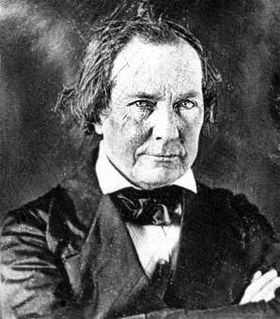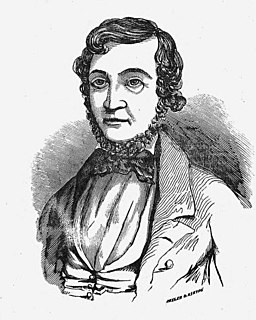
The Republic of Texas was a sovereign state in North America that existed from March 2, 1836, to February 19, 1846, although Mexico considered it a rebellious province during its entire existence despite the Treaties of Velasco of May 1836. It was bordered by Mexico to the west and southwest, the Gulf of Mexico to the southeast, the two U.S. states of Louisiana and Arkansas to the east and northeast, and United States territories encompassing parts of the current U.S. states of Oklahoma, Kansas, Colorado, Wyoming, and New Mexico to the north and west. The Anglo residents of the area and of the republic became known as Texians.

Stephen Fuller Austin was an American-born empresario. Known as the "Father of Texas" and the founder of Anglo Texas, he led the second and, ultimately, the successful colonization of the region by bringing 300 families and their slaves from the United States to the tejanos region in 1825.

Mirabeau Buonaparte Lamar was an attorney born in Georgia, who became a Texas politician, poet, diplomat, and soldier. He was a leading Texas political figure during the Texas Republic era. He was elected as the second President of the Republic of Texas after Sam Houston. He was known for waging war against bands of Cherokee and Comanche peoples to push them out of Texas, and for establishing a fund to support public education.

The Battle of Velasco, fought June 25-26, 1832, was the first true military conflict between Mexico and Texians in the Texas Revolution. It began when Texian Militia attacked Fort Velasco, located in what was then Velasco and what is now the city of Surfside Beach. The Mexican commander during the conflict, Domingo de Ugartechea, tried to stop the Texians, under John Austin, from transporting a cannon down the Brazos River to attack the city of Anahuac. The Texian Militia eventually prevailed over the Mexicans. Ugartechea surrendered after a two-day battle, once he realized he would not be receiving reinforcements, and his soldiers had almost run out of ammunition.

David Gouverneur Burnet was an early politician within the Republic of Texas, serving as interim President of Texas, Vice President of the Republic of Texas (1839–1841), and Secretary of State (1846) for the new state of Texas after it was annexed to the United States.

The Fredonian Rebellion was the first attempt by Anglo settlers in Texas to secede from Mexico. The settlers, led by Empresario Haden Edwards, declared independence from Mexican Texas and created the Republic of Fredonia near Nacogdoches. The short-lived republic encompassed the land the Mexican government had granted to Edwards in 1825 and included areas that had been previously settled. Edwards's actions soon alienated the established residents, and the increasing hostilities between them and settlers recruited by Edwards led Victor Blanco of the Mexican government to revoke Edwards's contract.

The Battle of Gonzales was the first military engagement of the Texas Revolution. It was fought near Gonzales, Texas, on October 2, 1835, between rebellious Texian settlers and a detachment of Mexican army soldiers.

Mexican Texas is the historiographical name used to refer to the era of Texan history between 1821 and 1836, when it was part of Mexico. Mexico gained independence in 1821 after winning its war against Spain, which began in 1810. Initially, Mexican Texas operated similarly to Spanish Texas. Ratification of the 1824 Constitution of Mexico created a federal structure, and the province of Tejas was joined with the province of Coahuila to form the state of Coahuila y Tejas.

The Battle of Goliad was the second skirmish of the Texas Revolution. In the early-morning hours of October 9, 1835, Texas settlers attacked the Mexican Army soldiers garrisoned at Presidio La Bahía, a fort near the Mexican Texas settlement of Goliad. La Bahía lay halfway between the only other large garrison of Mexican soldiers and the then-important Texas port of Copano.

The Anahuac disturbances were uprisings of settlers in and around Anahuac, Texas, in 1832 and 1835 which helped to precipitate the Texas Revolution. This eventually led to the territory's secession from Mexico and the founding of the Republic of Texas. Anahuac was located on the east side of the Trinity River near the north shore of Galveston Bay, which placed it astride the trade route between Texas and Louisiana, and from there to the rest of the United States. In new attempts to curtail smuggling and enforce customs tariffs from the coastal settlements, Mexico placed a garrison there after 1830. American settlers came into conflict with Mexican military officers, and rose up against them. They increased political activity and residents of numerous communities declared support for the federalists, who were revolting against the Mexican Government.

The Battle of Concepción was fought on October 28, 1835, between Mexican troops under Colonel Domingo Ugartechea and Texian insurgents led by James Bowie and James Fannin. The 30-minute engagement, which historian J. R. Edmondson describes as "the first major engagement of the Texas Revolution", occurred on the grounds of Mission Concepción, 2 miles (3.2 km) south of what is now Downtown San Antonio in the U.S. state of Texas.
The Convention of 1832 was the first political gathering of colonists in Mexican Texas. Delegates sought reforms from the Mexican government and hoped to quell the widespread belief that settlers in Texas wished to secede from Mexico. The convention was the first in a series of unsuccessful attempts at political negotiation that eventually led to the Texas Revolution.
The Convention of 1833, a political gathering of settlers of Mexican Texas, was a successor to the Convention of 1832, whose requests had not been addressed by the Mexican government. Despite the political uncertainty succeeding from a recently concluded civil war, 56 delegates met in San Felipe de Austin to draft a series of petitions to the Alamo. The volatile William H. Wharton presided over the meeting. Although the convention's agenda largely mirrored that of the Convention of 1832, delegates also agreed to pursue independent statehood for the province, which was at the time part of the state of Coahuila y Tejas. Under the guidance of Sam Houston, former governor of the US state of Tennessee, a committee drafted a state constitution to submit to the Mexican Congress. The proposed constitution was largely patterned on US political principles, yet retained several Spanish customs. Delegates also requested customs exemptions and asked that a ban on immigration into Texas be lifted.
The Consultation, also known as the Texian Government, served as the provisional government of Mexican Texas from October 1835 to March 1836 during the Texas Revolution. Tensions rose in Texas during early 1835 as throughout Mexico federalists began to oppose the increasingly centralist policies of the government. In the summer, Texians elected delegates to a political convention to be held in Gonzales in mid-October. Weeks before the convention and war began, the Texian Militia took up arms against Mexican soldiers at the Battle of Gonzales. The convention was postponed until November 1 after many of the delegates joined the newly organized volunteer Texian Army to initiate a siege of the Mexican garrison at San Antonio de Bexar. On November 3, a quorum was reached in San Antonio. Within days, the delegates passed a resolution to define why Texians were fighting. They expressed allegiance to the deposed Constitution of 1824 and maintained their right to form the General Council. In the next weeks, the council authorized the creation of a new regular army to be commanded by Sam Houston. As Houston worked to establish an army independent from the existing volunteer army, the council repeatedly interfered in military matters.

Haden Edwards was a Texas settler. Edwards County, Texas on the Edwards Plateau is named for him. In 1825, Edwards received a land grant from the Mexican government, allowing him to settle families in East Texas. His grant included the city of Nacogdoches, and Edwards soon angered many of the previous settlers. After his contract was revoked in 1826, Edwards and his brother declared the colony to be the Republic of Fredonia. He was forced to flee Mexico when the Mexican army arrived to put down the rebellion, and did not return until after the Texas Revolution had broken out.

A filibuster, also known as a freebooter, is someone who engages in an unauthorized military expedition into a foreign country or territory to foster or support a political revolution or secession. The term is usually applied to United States citizens who incited insurrections across Latin America, particularly in the mid-19th century, usually with the goal of establishing an American-loyal regime that may later be annexed into the United States. Probably the most notable example is the Filibuster War initiated by William Walker in Nicaragua.

To the People of Texas & All Americans in the World is an open letter written on February 24, 1836, by William B. Travis, commander of the Texian forces at the Battle of the Alamo, to settlers in Mexican Texas. The letter is renowned as a "declaration of defiance" and a "masterpiece of American patriotism", and forms part of the history education of Texas schoolchildren.
The history of slavery in Texas began slowly at first during the first few phases in Texas' history. Texas was a colonial territory, then part of Mexico, later Republic in 1836, and U.S. state in 1845. The use of slavery expanded in the mid-nineteenth century as White American settlers, primarily from the Southeastern United States, crossed the Sabine River and brought enslaved people with them. Slavery was present in Spanish America and Mexico prior to the arrival of American settlers, but it was not highly developed, and the Spanish did not rely on it for labor during their years in Spanish Texas.
Juan Davis Bradburn was a brigadier general in the Mexican Army. His actions as commandant of the garrison at Anahuac in Mexican Texas in 1831 and 1832 led to the events known as the Anahuac Disturbances.

Monroe Edwards was an American slave trader, forger, and criminal who was the subject of a well-publicized trial and conviction in 1842. Originally from Kentucky, Edwards moved to New Orleans then settled in Texas. He smuggled slaves into Brazil in 1832 and used the proceeds to purchase land in Texas. In 1836, he was again smuggling slaves, this time into Texas. After attempting to swindle his partner out of the profits of the venture, partly with forged documents, Edwards was forced to flee the Republic of Texas to the United States. He then tried to scam money out of various abolitionists in the United States and the United Kingdom, partly with forged letters of introduction. He traveled to the United Kingdom, but his schemes were mainly unsuccessful and he returned to the United States in mid-1841.













